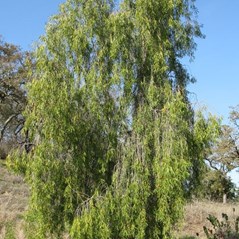Uses: Highly ornamental species for shade or shelter in wider locations reserves and parks. Planted in groups these shrubs can make an effective screen. Has a tendency to sucker, not suitable for urban streetscapes. Butterfly attracting.
Although called a native apricot the fruit is inedible.
Formerly: Pittosporum phylliraeoides
Cultural uses: Leaves and branches were boiled and used for medicinal purpose including a treatment for colds by Indigenous peoples.
Note: This species is provisionally classified schedule 1, Regulation 24.2 under the Sewerage Act. Written approval is required prior to planting in streets or roads. It should not be planted closer than two metres to any sewer main or connection.
Plant has been found to be fire retardant under certain growing conditions. For further information refer APS Web page: http://www.apsvic.org.au/plant_fire_resistant.html
This plant is indigenous to the following botanical regions of South Australia.
:NW: North Western
:LE: Lake Eyre
:NU: Nullarbor
:GT: Gairdner-Torrens
:FR: Flinders Rangers
:EA: Eastern
:EP: Eyre Peninsula
:NL: Northern Lofty
:MU: Murray
:YP: Yorke Peninsula
:SL: Southern Lofty
:KI: Kangaroo Island
:SE: South Eastern
For detail on these regions refer to the user guide.
- Height 6-10m
- Spread 1.5-5m
- Position
- Full Sun
- Family Pittosporaceae
- Botanical Name Pittosporum angustifolium
- Common Name Native Apricot, Weeping Pittosporum
- Origin SA, Vic, NSW, WA, Qld, NT
- Habit Dense, Spreading to weeping
- Landscape Coastal footslopes, Footslopes, Hills, Plains, 2nd line coast
- Soil Texture Clay, Loam, Sand
- pH Acidic, Alkaline, Neutral
- Tolerates Drought, Fire, Lime, Moderate frost
- Supplementary Watering Minimal
- Flower Colour Yellow
- Flowering Time Spring, Winter
- Flower Type Star
- Purpose Ornamental
- Form Small Tree (Up to 7m)
- Indigenous to the Adelaide Region







